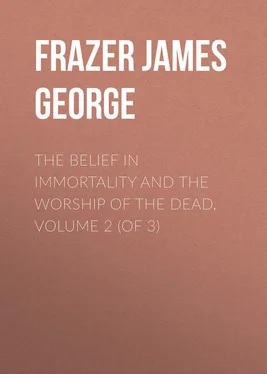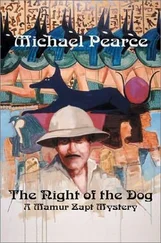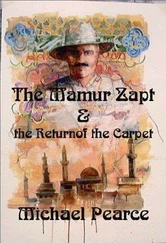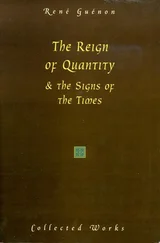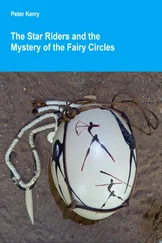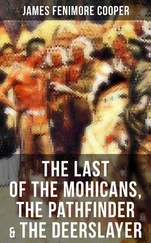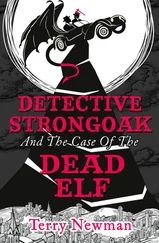James Frazer - The Belief in Immortality and the Worship of the Dead, Volume 2 (of 3)
Здесь есть возможность читать онлайн «James Frazer - The Belief in Immortality and the Worship of the Dead, Volume 2 (of 3)» — ознакомительный отрывок электронной книги совершенно бесплатно, а после прочтения отрывка купить полную версию. В некоторых случаях можно слушать аудио, скачать через торрент в формате fb2 и присутствует краткое содержание. Жанр: foreign_antique, foreign_prose, на английском языке. Описание произведения, (предисловие) а так же отзывы посетителей доступны на портале библиотеки ЛибКат.
- Название:The Belief in Immortality and the Worship of the Dead, Volume 2 (of 3)
- Автор:
- Жанр:
- Год:неизвестен
- ISBN:нет данных
- Рейтинг книги:3 / 5. Голосов: 1
-
Избранное:Добавить в избранное
- Отзывы:
-
Ваша оценка:
- 60
- 1
- 2
- 3
- 4
- 5
The Belief in Immortality and the Worship of the Dead, Volume 2 (of 3): краткое содержание, описание и аннотация
Предлагаем к чтению аннотацию, описание, краткое содержание или предисловие (зависит от того, что написал сам автор книги «The Belief in Immortality and the Worship of the Dead, Volume 2 (of 3)»). Если вы не нашли необходимую информацию о книге — напишите в комментариях, мы постараемся отыскать её.
The Belief in Immortality and the Worship of the Dead, Volume 2 (of 3) — читать онлайн ознакомительный отрывок
Ниже представлен текст книги, разбитый по страницам. Система сохранения места последней прочитанной страницы, позволяет с удобством читать онлайн бесплатно книгу «The Belief in Immortality and the Worship of the Dead, Volume 2 (of 3)», без необходимости каждый раз заново искать на чём Вы остановились. Поставьте закладку, и сможете в любой момент перейти на страницу, на которой закончили чтение.
Интервал:
Закладка:
But these are intricate questions which await future investigation. I cannot enter into them now, but must confine myself to my immediate subject, the beliefs of the Polynesians concerning the human soul and the life after death.
In spite of their diffusion over a multitude of islands separated from each other by hundreds and even thousands of miles of ocean, the Polynesians are on the whole a remarkably homogeneous race in physical type, language, and forms of society and religion. The differences of language between them are inconsiderable, amounting to little more than some well-marked dialectical variations: all dwell in settled homes and subsist partly by fishing partly by the fruits of the earth, tilling the soil and gathering coconuts and bread-fruit from the trees: 9 9 J. Deniker, The Races of Man , p. 501. On the apparent homogeneity of the Polynesian race see W. H. R. Rivers, The History of Melanesian Society (Cambridge, 1914), ii. 280, who, however, argues (ii. 280 sqq. ) that the race has been formed by the fusion of two distinct peoples.
all are bold and expert mariners, making long voyages in large well-built canoes: all possess a copious and comparatively well developed mythology; and all at the time of their discovery enjoyed, or perhaps we should rather say suffered from, a singular institution, half social, half religious, which may be summed up in the single Polynesian word taboo. Hence it would no doubt be possible to give a general account of the belief in human immortality which would hold good in outline for all the different branches of the Polynesian race; but such an account would necessarily be somewhat meagre, inexact in detail, and liable to many exceptions. Accordingly I shall not attempt it, but shall describe the creed of each group of islanders separately. As the beliefs of the various islanders on this momentous topic are characterised by a general similarity, the method I have adopted will no doubt involve a certain sameness and repetition, but for the serious student of comparative religion I hope that these disadvantages may be more than outweighed by the greater accuracy and fulness of detail which this mode of treating the subject renders possible.
The principal groups of islands included in Polynesia are New Zealand, the Friendly or Tonga Islands, the Samoan or Navigators Islands, the Hervey or Cook Islands, the Society Islands, including Tahiti, the Marquesas Islands, and Hawaii or the Sandwich Islands. 10 10 Horatio Hale, United States Exploring Expedition, Ethnography and Philology (Philadelphia, 1846), pp. 4 sqq.
All of them, except New Zealand, are within the tropics; and all of them, except Hawaii, lie to the south of the equator. I shall deal with them in the order I have mentioned, beginning with New Zealand.
§ 2. The Maoris of New Zealand
The Maoris of New Zealand are not aborigines of the islands which they inhabit: they possess long and apparently in the main trustworthy traditions of their migration to New Zealand many generations ago. The circumstances which led to the migration, the names of the canoes in which it was accomplished, the names and genealogies of the chiefs who conducted it, are all recorded, having been handed on by word of mouth from generation to generation, till they were finally written down from the lips of the natives by English enquirers. 11 11 E. Dieffenbach, Travels in New Zealand (London, 1843), ii. 85 sqq. ; Horatio Hale, United States Exploring Expedition, Ethnography and Philology (Philadelphia, 1846), pp. 146 sqq. ; Sir George Grey, Polynesian Mythology (London, 1855), pp. 123 sqq. , 136 sqq. , 162 sqq. , 202 sqq. ; E. Shortland, Traditions and Superstitions of the New Zealanders , Second Edition (London, 1856), pp. 1 sqq. ; R. Taylor, Te Ika A Maui, or New Zealand and its Inhabitants , Second Edition (London, 1870), pp. 26, 27, 289 sqq. ; John White, The Ancient History of the Maori, his Mythology and Traditions (London, 1887-1889), ii. 176 sqq. ; Elsdon Best, "The Peopling of New Zealand," Man , xiv. (1914) pp. 73-76. The number of generations which have elapsed since the migration to New Zealand is variously estimated. Writing about the middle of the nineteenth century Shortland reckoned the number at about eighteen; Mr. Elsdon Best, writing in 1914, variously calculated it at about twenty-eight or twenty-nine (on p. 73) and from eighteen to twenty-eight (on p. 74).
The place from which the Maoris came is unanimously designated as Hawaiki, an island or group of islands lying far to the north or north-east of New Zealand. Among English scholars there is some difference of opinion whether Hawaiki is to be identified with Hawaii, that is, the Sandwich Islands, or with Savaii, one of the Samoan or Navigators Islands, since Hawaii and Savaii are both dialectical variations of the New Zealander's pronunciation of Hawaiki. 12 12 E. Shortland, Traditions and Superstitions of the New Zealanders , p. 33.
Though Hawaii is more than twice as far as Savaii from New Zealand, being separated from it by almost the whole breadth of the tropics and a great stretch of ocean besides, some good authorities have inclined to regard it as the original home of the Maoris, but the balance of opinion appears now to preponderate in favour of the view that Savaii was the centre from which the Polynesians dispersed all over the Pacific. 13 13 H. Hale, Ethnography and Philology of the U.S. Exploring Expedition , pp. 119 sq. ; E. Dieffenbach, Travels in New Zealand (London, 1843), ii. 85 sqq. ; E. Shortland, Traditions and Superstitions of the New Zealanders , pp. 33 sqq. ; A. S. Thomson, The Story of New Zealand (London, 1859), i. 57 sqq. ; R. Taylor, Te Ika A Maui , p. 26; E. Tregear, Maori-Polynesian Comparative Dictionary (Wellington, N.Z., 1891), pp. 56 sqq. , s. v. "Hawaiki"; A. C. Haddon, The Wanderings of Peoples (Cambridge, 1919), p. 36. Of these writers, Dieffenbach, Shortland, and Taylor decide in favour of Hawaii; Thomson, Hale, and Haddon prefer Savaii; Tregear seems to leave the question open, pointing out that "the inhabitants of those islands themselves believe in another Hawaiki, neither in Samoa nor Hawaii."
However, the question is one that hardly admits of a positive answer.
The Maoris are not a pure-blooded Polynesian race. Among them even at the present day two distinct racial types may be distinguished, one of them the comparatively fair Polynesian type with straight nose and good features, the other the swarthy, thick-lipped, flat-nosed, frizzly-haired Melanesian type. They have a tradition that on their arrival in New Zealand they found the country in the possession of a dark-skinned folk of repulsive appearance, tall, spare, and spindle-shanked, with flat faces, overhanging brows, and noses of which little but the upturned nostrils could in some cases be discerned. These savages wore little clothing and built no good houses, nothing but rude shelters against the inclemency of the weather. They were ignorant and treacherous, and the Maoris regarded them with dislike and contempt; but their women looked with favour on the handsome Maori men, and a mixture of the two races was the result. This tradition both explains and is confirmed by the two different racial types which still exist side by side or blent together among the Maoris. It seems, therefore, highly probable that before the advent of the Maoris the North Island of New Zealand was occupied by a people of inferior culture belonging to the Melanesian stock, who may themselves have had a strain of Polynesian blood in their veins and some Polynesian words in their language. This at least is suggested by some features in the Maori traditions about them. For these savages told the Maoris that they were the descendants of the crews of three fishing canoes which had been driven to sea from their own land in past times, and that their original home was a much warmer country than New Zealand. All these various indications may perhaps be reconciled by supposing that the dark predecessors of the Maoris in New Zealand were a Melanesian people, who had accidentally drifted from Fiji, the inhabitants of which have long been in contact with their Polynesian neighbours on the east, the Tongans. 14 14 Elsdon Best, "The Peopling of New Zealand," Man , xiv. (1914) pp. 73-76. The Melanesian strain in the Maoris was recognised by previous writers. See J. S. Polack, Manners and Customs of the New Zealanders (London, 1840), i. 6, "The nation consists of two aboriginal and distinct races, differing, at an earlier period, as much from each other as both are similarly removed in similitude from Europeans. A series of intermarriages for centuries has not even yet obliterated the marked difference that originally stamped the descendant of the now amalgamated races. The first may be known by a dark-brown complexion, well formed and prominent features, erect muscular proportions, and lank hair, with a boldness in the gait of a warrior, wholly differing from that of the second and inferior race, who have a complexion brown-black, hair inclining to the wool, like the Eastern African, stature short, and skin exceeding soft." The writer rightly connects the latter people with the stock which we now call Melanesian. Compare also R. Taylor, Te Ika A Maui , pp. 13 sqq. , who says (p. 13), "The Melanesian preceded the Polynesian… The remains of this race are to be seen in every part of New Zealand, especially among the Nga-ti-ka-hunu, to which the derisive name of Pokerekahu – Black Kumara – is applied. The Maori traditions preserve both the names of the canoes which brought them to New Zealand, as well as of the chiefs who commanded them; several of these records make mention of their having found this black race in occupation of the country on their arrival." The blending of two distinct races, a light-brown and a dark race, among the Maoris is clearly recognised by E. Dieffenbach, Travels in New Zealand , ii. 8-11. The dark race, he says (pp. 9 sq. ), "has undoubtedly a different origin. This is proved by their less regularly shaped cranium, which is rather more compressed from the sides, by their full and large features, prominent cheek-bones, full lips, small ears, curly and coarse, although not woolly, hair, a much deeper colour of the skin, and a short and rather ill-proportioned figure. This race, which is mixed in insensible gradations with the former, is far less numerous; it does not predominate in any one part of the island, nor does it occupy any particular station in a tribe, and there is no difference made between the two races amongst themselves; but I must observe that I never met any man of consequence belonging to this race, and that, although free men, they occupy the lower grades; from this we may perhaps infer the relation in which they stood to the earliest native immigrants into the country, although their traditions and legends are silent on the subject."
They received from the Maoris the name of Maruiwi, 15 15 Elsdon Best, "The Peopling of New Zealand," Man , xiv. (1914) pp. 73 sq.
and were perhaps of the same stock as the Moriori of the Chatham Islands; for two skulls of the Moriori type have been found in an old deposit at Wanganui, near the south end of the North Island of New Zealand. 16 16 (Sir) Arthur Keith, "Moriori in New Zealand," Man , xiii. (1913) pp. 171 sq.
Интервал:
Закладка:
Похожие книги на «The Belief in Immortality and the Worship of the Dead, Volume 2 (of 3)»
Представляем Вашему вниманию похожие книги на «The Belief in Immortality and the Worship of the Dead, Volume 2 (of 3)» списком для выбора. Мы отобрали схожую по названию и смыслу литературу в надежде предоставить читателям больше вариантов отыскать новые, интересные, ещё непрочитанные произведения.
Обсуждение, отзывы о книге «The Belief in Immortality and the Worship of the Dead, Volume 2 (of 3)» и просто собственные мнения читателей. Оставьте ваши комментарии, напишите, что Вы думаете о произведении, его смысле или главных героях. Укажите что конкретно понравилось, а что нет, и почему Вы так считаете.
